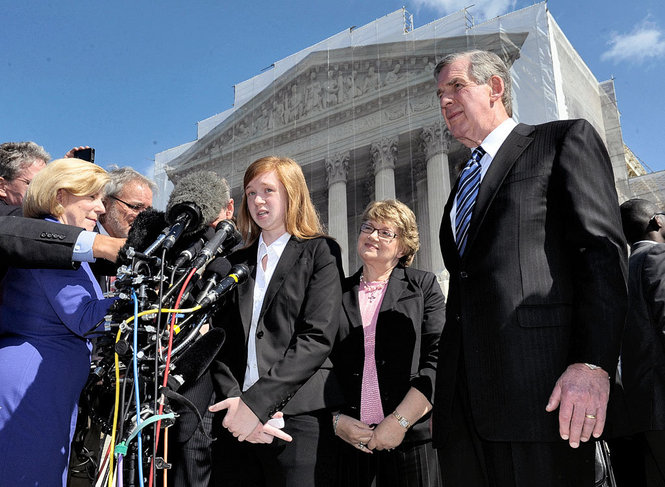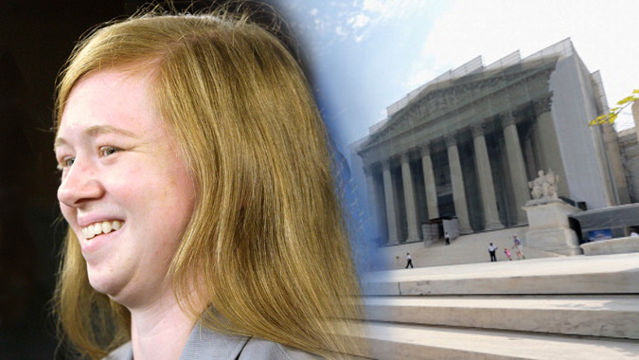Affirmative action (particularly the race-based variant of it) has long proven a controversial issue in the USA for many reasons. Strong feelings exist on both sides of the aisle. Conservative forces call race-based affirmative action an affront to the legacy of civil rights, and even go as far in some cases as to equate themselves to historical figures like MLK and Medgar Evars as the inheritors of a anti-racist legacy.
On the other side, liberal forces equate the maintenance of race-based affirmative action to the maintenance of America’s moral legitimacy, claiming that the policies are essential to the reparation of past inequities/atrocities and that society is morally obligated to see said reparation through at all costs.
Both sides got their chance to be heard on America’s largest legal stage recently thanks to a young female plaintiff named Abigail Fisher.
A (mediocre looking) Texan, Fisher applied to the University of Texas at Austin in 2008 and was rejected. With the backing of conservative donors and activists (including her father, a legacy at UT whose longtime friend and classmate Edward Blum has lead Fisher’s legal charge), Fisher filed suit claiming that her race was used unfairly against her. The case was, obviously, a direct challenge to the use of race in college admissions, specifically UT-Austin’s consideration of race (along with dozens of other factors) as part of its “holistic admissions” process for students like Fisher who do not qualify for automatic admission to the school via the state’s “10 Percent Plan” (more on that plan later).
Fisher ‘s case was defeated in all of the lower courts, and many observers were surprised to see the Supreme Court take the case on appeal. The result of their examination, however, was less surprising: the court essentially punted the issue, handing it back down to a lower court and asking them to do what amounted to a “do over”.
I say that this result was unsurprising because anyone, upon closer examination of Fisher’s merits, could see that she was not the ideal poster child for white victimization at the hands of affirmative action. Here is why she proved to be a waste of time:
1. She didn’t have particularly good numbers.
Fisher had a 3.59 GPA and an 1180 SAT score. UT-Austin offers automatic admission to all students who finish within the top 10% of their high school classes, and Fisher failed to do that. UT-Austin admits the majority of its students via this 10% plan, so this forced Fisher into a very competitive pool of applicants seeking the remaining spots in the class (just 8% of UT-Austin’s in-state slots in 2008 went to students admitted outside of the 10% plan). That she failed with her scores was not surprising, since they didn’t stand out among her group.
2. She can’t prove that her race was used against her.
UT-Austin evaluates candidates who fall outside of their 10% auto-admit group on a host of factors. Race is just one of them, and Fisher has offered no evidence to show that it (and not the dozens of other alternatives) was the key that pushed her out of contention.
In their bid to substantiate that claim, Fisher and her supporters have argued that minorities with lower scores than hers were getting into the school, claiming that the only difference between these minorities and Fisher was racial. The numbers do not back this up:
Fisher did not particularly stand out. Court records show her grade point average (3.59) and SAT scores (1180 out of 1600) were good but not great for the highly selective flagship university. The school’s rejection rate that year for the remaining 841 openings was higher than the turn-down rate for students trying to get into Harvard.
As a result, university officials claim in court filings that even if Fisher received points for her race and every other personal achievement factor, the letter she received in the mail still would have said no.
It’s true that the university, for whatever reason, offered provisional admission to some students with lower test scores and grades than Fisher. Five of those students were black or Latino. Forty-two were white.
Neither Fisher nor Blum mentioned those 42 applicants in interviews. Nor did they acknowledge the 168 black and Latino students with grades as good as or better than Fisher’s who were also denied entry into the university that year. Also left unsaid is the fact that Fisher turned down a standard UT offer under which she could have gone to the university her sophomore year if she earned a 3.2 GPA at another Texas university school in her freshman year.
Again, Fisher has argued along with her supporters that race was the key to her rejection, citing her scores and parroting the notion that less qualified minorities “took her spot”. Yet the numbers show that the vast majority of those admitted ahead of Fisher despite being “less qualified” than (at least as far as test scores and GPA’s went) were actually white, just like Fisher. Further, there were hundreds of black and Hispanic students with numbers at or above Fisher’s level who, like Fisher, failed to gain admission. These rejected minorities outnumber the supposedly “less qualified” minorities admitted ahead of Fisher by a factor of more than 33.
Even Fisher’s primary backer, Edward Blum, had to admit the absurdity of it all:
In an interview last month, Blum agreed Fisher’s credentials and circumstances make it difficult to argue — as he and his supporters have so ardently in public — that but for her race Fisher would have been a Longhorn.
And yet the saga continued.
The debate over affirmative action is not over, and it will not be going away anytime soon. Fisher’s case has been punted, but that only means that the lower court will be revisiting it in a year’s time. Furthermore, other cases relating to affirmative action are likely to pop up in the coming years.
That being said, those looking to challenge the viability of race based affirmative action are going to continue to have a hard time doing so with the likes of Abigail Fisher leading their way. Fisher is a an average individual who displays a strong sense of entitlement to above-average outcomes, using scapegoats to cover herself in the event of her inevitable failure to achieve them. That any time was wasted considering the inevitable and entirely defensible results of her entitlement in this land’s highest court of law is disappointing. If such individuals come to be associated too often with the anti-affirmative action cause, then it will continue to struggle to gain ground.
Read Next: Top 10 Colleges For Getting Laid




